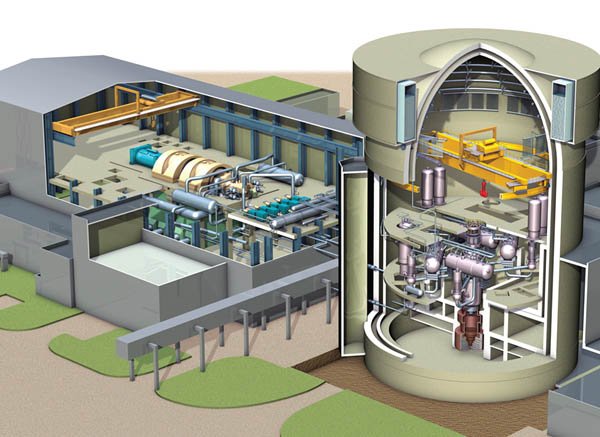
Rooppur Nuclear Power Plants (RNPP) I&II are coming into being near Ishurdi on the river Padma using Russian VVER-1200 reactors with a total installation capacity of 2,400 MW by the year 2023. It is a giant leap towards fuel diversification in power generation. Yet the need of uranium based power plants begets some complementary needs to be fulfilled and they are: backup for steady supply of cooling water, radioactive waste disposal and robust power grid to supply clean electricity. The article will try to discuss the importance of these needs and advocate their implementation for the safety and success of the project.
Uncertain Cooling Water
A realistic estimation of the total requirement of cooling water is not available for the Rooppur nuclear power plants. What is known from different quarters now and then is only a partial picture which mentions the quantity of makeup water that has to be added to the re-circulatory condenser water system to compensate for the evaporation loss of water in cooling towers. For example, Maksim V Elchyschev, Russian in-charge of RNPP stated that makeup water for evaporation and drift losses is 259,200 m3/ day which is equal to 3 m3/ sec (News Today dated 30.03.2016). Yearly water requirement is 81m cubic meter i.e. 2.6 m3/sec. as advised to GK project by the authority.(Bangladesh Protidin dated 16.04.2016) Both the figures apply to single unit of 1,200MW only and cooling water need for services is not considered.
The magnitude of cooling water need of a nuke plant cannot be equated with that of normal thermal power plant which enjoys some distinct advantages. A thermal power plant can release the excess heat to atmosphere through the chimney. Again unlike a nuke plant a thermal power plant does not have spent fuel pond to cool down. On the other hand the nuclear power plant is completely enveloped and has to use water to absorb heat from inside and reject it to the environment outside. The plant needs cooling water for the auxiliary services like turbine oil cooler, generator cooler and chillers of air conditioning system. NPP also needs cooling water for emergency services and spent fuel cooling. The plant has to bear the burden of cooling the spent fuel rods, though not useful any more, in a pond of water inside the reactor hall for years after years with care. This cooling need is crucial as radioactive water at high temperature produces hydrogen which can cause explosion in the space. The cooling water requirement for all services together will be about 2.5m3/s per plant and water will pass once through the heat exchangers and then return back to the river after effluent treatment. All cooling water for the plant is to be clean and treated.
Thus the overall cooling water requirement for RNPP 1&2 will be 18m3/s including allowance for water treatment. The Ganges-Kobatak Irrigation Pump house, situated on the other bank of river Padma, runs at a reduced capacity and withdraws 85m3/s for irrigation. The total withdrawal of water at the same section of the river stands at 103m3/s which will be very critical in dry season when the flow and level of water in the river go down drastically.
The mean minimum flow of water in five years (2008-12) in river Padma was 514m3/s. The need of water 103m3/s is 20% of river flow whereas withdrawal should be limited within 2-3% for the sake of marine life and ecology. A situation similar to 2011(min flow 87m3/s) would be a disaster as requirement is more than the river flow.
A river feeding a nuke plant on its bank should have a backup water reservoir. As for example, Novovorenzh II (VVER-1200), the reference power plant for Bangladesh in Russia stands on the river Don which is supported by a dam named Tsimlyansk.
That there is a shortage of water potential in the river Padma in dry season, poses a challenge for the authority to improve the water resources to ensure steady supply of water to both the projects throughout the year.
Waste Management and Disposal
Bangladesh happily signed contract with Russia for two VVER-1200 nuclear power plants with the firm understanding that Russia would take back the radioactive wastes and spent fuel rods. The euphoria melted in thin air when Rosatomlater expressed unwillingness to take back the radioactive wastes and would take spent fuel rods, only to collect the uranium and return the casings to Bangladesh for burial. RNPP authority has no other alternative but to arrange its own disposal system for the radioactive waste materials.
Radioactive wastes are generated during various operations in a nuclear power plant. They are in the form of gas, liquid and solid. Solid wastes are again classified as Low Level Waste (LLW), Mid Level Waste (MLW) and High Level Waste (HLW) depending on the nature of radioactivity. These wastes can remain radioactive from a few years to thousands of years.
Gaseous Radioactive Waste
Radioactive contamination takes place in the plant room air from normal operation and maintenance work. The level of airborne radioactivity is controlled by an efficient ventilation system. The room air is passed through the filtration system containing pre-filters, fine filters (high efficiency particulate arrestors) and carbon absorbers before it is exhausted to the atmosphere. A negative pressure is maintained in the reactor hall to prevent airborne contamination from spreading to the adjacent areas.
Liquid Radioactive Waste
Radioactive waste water coming from reactor cooling circuit and spent fuel cooling pond are to be solidified by a process called vitrification in the matrix of borosilicate to form blocks. The blocks are then put in canisters and sent for burial.
Radioactive Solid Waste
LLW contains small amount of radioactivity. They are materials like paper, rags, clothing, tools, shoes, filters and disposables which constitute 90% of total volume and 1% of total waste radioactivity. They are suitable for shallow burial to isolate them from people and environment. They are conditioned by incineration and compaction to reduce volume before disposal.
ILW contains higher amount of radioactivity and requires shielding. It generally comprises resins, chemical sludge, metal and fuel cladding and contaminated materials from reactor decommissioning. Slurries and small metal pieces are solidified in concrete or bitumen before disposal. Big metals are cut and mechanically compacted to be put in containers for burial. They constitute 7% volume and 4% radioactivity of all rad-waste. They should be buried deep underground, as deep as 200-600m.
HLW come from burning of nuclear fuel in the reactor core. They are the spent fuel rods which are highly radioactive and hot due to decay heat. After withdrawal the spent fuel rods are kept in a water pond, by the side of the reactor, about 3m deep under water which provides cooling and shielding. This wet storage continues for 5to 10 years. Thereafter they are taken out and sealed in special capsules (called casks) to be transferred to dry storage for longer period, even for the whole life of the plant. As HLW contains 95% of the radioactivity which lasts for thousands of years, the ultimate solution is to store them in a deep underground graveyard called geological repository.
RNPP now faces a great challenge to find a place in the country suitable for deep geological repository. It is all the more necessary as the nuclear electricity program is going to be expanded and reprocessing of spent fuel rods does not eliminate the need of a repository as the remnants are to be buried there anyway. The site is to be carefully selected so that the ground water is not contaminated. The search and acquirement of an area of land are better done in this decade or else it will be far more difficult for the future generation after sixty years when 30 crore people will live in the small country of Bangladesh.
Robust National Grid
The national grid of Bangladesh is fairly stable but not strong. It cannot withstand sudden big shock. On November 1, 2014, the worst ever grid failure occurred when the supply of cross-border electricity of 444MW momentarily disappeared at HVDC conversion centre at Bheramara, Bangladesh. If a supply of a much higher input of 1,000 MW goes off suddenly when RNPP trips for some reason, the existing grid will not be able to resist a failure and blackout. There is again a drawback thatVVER-1200 plant cannot start immediately after a blackout because it needs about 90 MW power from the grid to run the drives to restart.
It is the frequency that drops down the threshold at a sudden fall of generation and causes a blackout which can be prevented if a substantial load is shed a second earlier than the generation loss. RNPP, a large power plant it is, is to coordinate with the grid system in a way that an automatic load shedding can be executed simultaneously when it trips. It can be done by sharing of information and software interlocking of trip sensor and feeder breakers.
Power Grid Company of Bangladesh faces a challenge to modernize the grid to the international standard. The quality of electricity has to be improved to maintain the frequency very close to 50 Hz. At present, the fluctuation of frequency is too much (48-52 Hz.) which may not be compatible to RNPP. Because, the stray frequencies cause errors in digital circuits and are not good for sensitive electronics.
Conclusion
A nuclear power plant is a delicate technology and so should be built and operated with care. Shortage of water should not weaken the plant and an excessive withdrawal of river water should not disrupt the riverine ecology. The radioactive waste disposal should not harm population and environment. Overcoming these issues will determine the sustainability of the plants.
K.M. Mahbubur Rahman;
Senior Mechanical Engineer,
mahbub.r_407@yahoo.com



